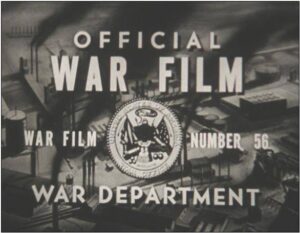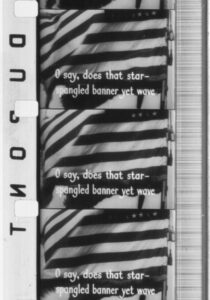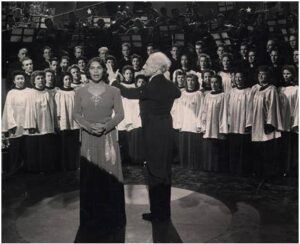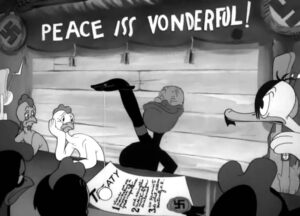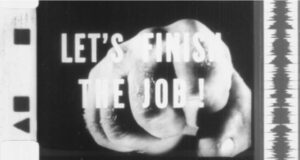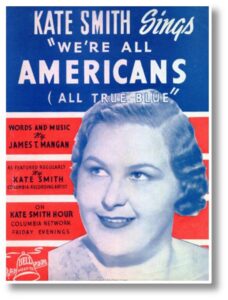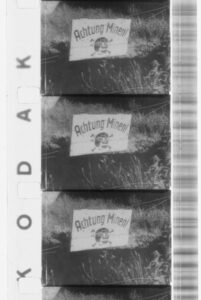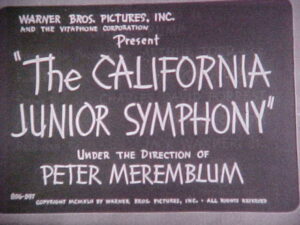THE STAR SPANGLED BANNER
National Screen Service/Official Films, c.1940
It was once common to begin theatrical screenings with our National Anthem. This brief reel from the late 30s/early 40s is a theatrical sing-along to The Star Spangled Banner that was re-issued by Official Films on 16mm for non-theatrical use. (Dupont 719B film stock, density sound track)
________________________________________
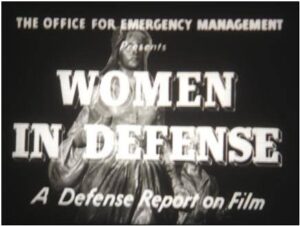
WOMEN IN DEFENSE
Released May 28, 1941, re-released following Pearl Harbor on December 24, 1941. Produced by the Office of Emergency Management and War Activities Committee of the Motion Picture Industry. Written by Eleanor Roosevelt and narrated by Katharine Hepburn.
We needed to be convinced that women were a capable and valuable part of the defense of the U.S. In this film we see women working as scientists and munition workers, jobs that had been exclusively held by men. We also see them sewing parachutes.
(1941 Kodak film stock, density sound track)
__________________________________________
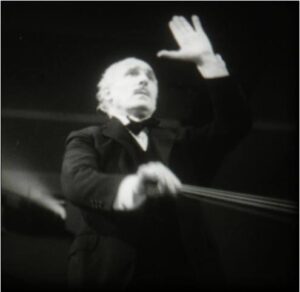
HYMN OF THE NATIONS: TOSCANINI CONDUCTS THE MUSIC OF GUISEPPE VERDI
Released to our allies and in territories liberated from the Nazis in 1944. Released in the U.S. in 1946. Produced by the U.S. Government War Department.
Magnificent performances of Verdi’s “The Force of Destiny” overture and “Hymn of the Nations” by legendary conductor Arturo Toscanini, (1867-1957, his only film), the NBC Symphony Orchestra, tenor Jan Peerce (1904-1984) and the Westminster College Choir from Princeton, New Jersey.
Rarely seen today in it’s original release version, this great film was shown first to our allies in Europe and in territories that had been liberated from the Nazis. It was not shown in the U.S. until 1946.
Most post-war prints are missing the central portion of the film which tells about Toscanini and other Italians who were in exile in the US to escape Fascism in their homeland. Also removed during the McCarthy era was the playing of the Soviet National Anthem. All of that footage is still missing from a recent DVD release as well as the release seen on the web page of the National Archives. But all footage and music has been restored in this print, including the footage of the NBC Symphony rising to their feet to play Toscanini’s own arrangement of the Star Spangled Banner at the conclusion of the film. (1976 Eastman film stock, density sound track)
_____________________________________________
DUCKTATORS
Warner Bros. August 1, 1942
The legendary voice of Mel Blanc, the manic music of Carl Stalling and the famous Termite Terrace style of the Warner animation department combine to lampoon Hitler, Tojo and Mussolini. This great cartoon deftly uses humor to boost our moral and sink the Axis.
(Sunset Productions edition, 2001 Kodak Mylar film stock, density sound track)
_____________________________________________

RECOGNITION OF THE
JAPANESE ZERO FIGHTER
First Motion Picture Unit, Army Air Force, Directed by Bernard Vorhaus, 1943. “Dedicated to the flyers who are helping to make the total number of Zeros … ZERO.”
Instructional film for pilots to teach them the difference between the Japanese Zero and our own P-40 so they wouldn’t shoot down our own planes when they appeared as just a tiny blip on the horizon.
No cast or crew screen credits are given, but the young man portraying Lt. Jimmy Saunders is a 32-year-old Hollywood actor (who joined the ranks during WWII) then known as Captain Ronald Reagan. The part of Lt, Weldon, the P-40 flyer that Reagan almost shoots down, is played by Craig Stevens, later known as television’s Peter Gunn. Narration is by Art Gilmore who was the announcer on Red Skelton’s TV show and the voice on so many movie previews from the 40s through the 60s. The major is played by Harry Stevens.
(Dupont 644A film stock, density sound track.)
________________________________________________
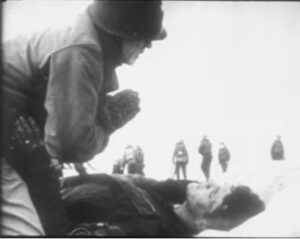
NEWS PARADE:
THE BATTLE FOR OKINAWA / BOMBING OF USS FRANKLIN
Castle Films, 1945, edited by Eugene Castle, narrated by Len Sterling.
Produced for home use, this newsreel is loaded with gripping Signal Corp and Navy Combat Cameraman footage showing US military under fire. The section about the bombing of the carrier USS Franklin has some of the most amazing WWII combat footage you will ever see including sailors fighting the fires on deck as the Japanese continue to attack the ship.
You will also see Father Joseph O’Callahan (shown in photo above), and after the screening I will explain why he was awarded the Congressional Medal of Honor. It’s quite a story!
The silent version of this film is available to view on-line, but this is a very rare and excellent condition sound print of this great war-time newsreel. (1945 Kodak film stock, variable area sound track)
_____________________________________________________
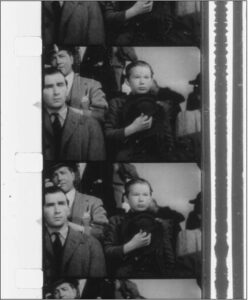
OUR AMERICAN HERITAGE
RKO/American Heritage Foundation, Sponsored by the Attorney General of the United States, 1947.
Following the end of WWII Americans were weary of flag waving and just wanted to get on with their private lives.
The Truman administration was concerned that we were becoming less interested in our duties as citizens. The National Archives responded with a plan to inspire Americans to be proud and active citizens. It was decided to have a train tour the entire county carrying artifacts significant to our history and inviting all citizens to come and see them. This idea became “The Freedom Train.” Tom Clark, the Attorney General under Harry Truman, became the official sponsor. “Rededication Week” was declared when the train visited your community. The theme of the train was “Freedom is everybody’s job.”
From September of 1947 to January of 1949 the Freedom Train zig-zagged across the US visiting 322 communities. Displayed on the train were Jefferson’s draft of the Declaration of Independence, the Iwo Jima flag, an original copy of the Magna Carta from 1215, the copy of Lincoln’s Gettysburg Address that he held in his hand when delivering that speech, and many other significant artifacts.
Citizens could board the train to view the artifacts which were guarded by the Marines, and then sign the Freedom Scroll which was presented to president Truman at the end of the tour.
About one fourth of the population turned out to see the train, far too many for them all to get inside, so more displays and numerous activities were presented outside the train.
This inspirational film was produced to coincide with the arrival of the Freedom Train in local communities, and has rarely been seen since 1949. Narrated by Joseph Cotten, (uncredited). (unidentified and undated film stock, variable area sound track)
___________________________________________________
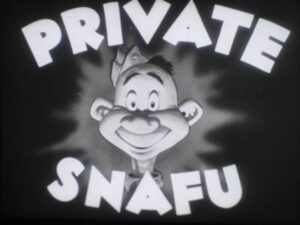
WAR FILM #18,
FILM COMMUNIQUE, 7th ISSUE
War Department, Signal Corps Production, with the cooperation of Combat Film Units, Army Air Forces and the United States Navy. Exclusive for the Men and Women of American Industry, 1945.
Shown to civilian war workers in American factories, this is an excellent example of how the government used 16mm film to boost morale and to impress upon civilian war workers how vital it was to stay on the job and work hard because the very survival of the country depended on them.
Part 1: “Burma Outpost” tells of the tranquil but vital job some soldiers were doing in remote regions of the South Pacific monitoring Japanese air activity.
Part 2: “Private SNAFU.” This is the first time a Private SNAFU cartoon was shown to civilians. SNAFU was a cartoon character created by Dr. Seuss and animated by Warner Bros to show our soldiers the effects of doing things the wrong way.
Part 3: “What Makes a Battle” is an increasingly intense narrative about how difficult it is for our military in the war zone. The segment ends with some grizzly images of dead American soldiers being finger printed on a beach. Narrated by Fredric March, (uncredited).
(1944 Kodak film stock, variable area sound track)
_______________________________________________
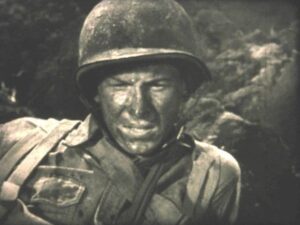
BAPTISM OF FIRE
United States Army, 1943.
With Elisha Cook Jr., Peter Whitney. Nominated for the 1944 Academy Award for Best Documentary, this Army training film focuses on the basic psychological human questions asked by all soldiers everywhere: How will I perform under enemy fire? Will I run away or will I do what I’ve been trained to do?
The film depicts seasoned soldier Bill telling new soldier Jim to think of his buddies and his weapon instead of his own fears and of home.
Killing an enemy from afar is vividly contrasted with hand-to-hand combat, butt strokes and bayonet thrusts.
At first shown to both military and civilian audiences, this realistic and bloody shocker worried the War Department because of its portrayal of vulnerable soldiers, so its availability was ultimately restricted.
(1943 Kodak film stock, variable area sound track)
_____________________________________________
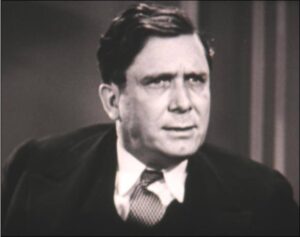
QUESTIONS AND ANSWERS
WITH WENDELL WILLKIE
Republican National Committee, 1940.
1940 Republican presidential candidate Wendell Willkie offers scripted answers to scripted questions about his views of the national scene including the war then looming in Europe, (he vows to never send Americans to fight on foreign shores), and about what he sees as the democracy ending tragedy of a third term for FDR.
This is a fascinating piece of history. How differently such a campaign film would be handled in the 21st century! (Undated Dupont 337B film stock, variable area sound track)
____________________________________________
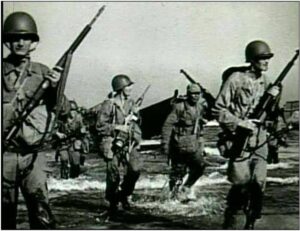
UNITED STATES COAST GUARD REPORT No. 7:
THE COAST GUARD AT WAR ON FOREIGN SHORES
US Government, 1946.
The US Coast Guard is seldom mentioned when WWII history is discussed, but they were involved around the world in every major battle in both theaters of war. This film gives us a fascinating account of the Guard’s activities.
Some excellent Signal Corps footage shows the Coast Guard sinking German subs, shooting down planes and capturing German spies in Greenland. (Greenland was strategic for predicting the weather over Europe and England.) The Guard is also shown under fire in major battles in Europe and the South Pacific as they assisted all branches of the US military. (1945 Kodak film stock, variable area sound track)
____________________________________________
HANDS
US Government War Department, 1944.
Official US government film promoting the sale of war bonds for the 6th war bond drive in November of 1944.
Note: some disturbing images of wounded soldiers are shown in this film. (1944 Kodak film stock, variable area sound track)
_______________________________________________
AMERICA SINGS
WITH KATE SMITH
Columbia, 1942.
Kate Smith invites you to sing with her on four patriotic songs: “We’re All Americans,” “The Caissons Go Rolling Along,” “The Marines Hymn,” and “America, I Love You.”
Though a super star on radio and records, success in the movies eluded Kate Smith, but her sincerity comes through strongly in this patriotic morale booster.
(1976 Eastman film stock, variable area sound track)
_______________________________________________
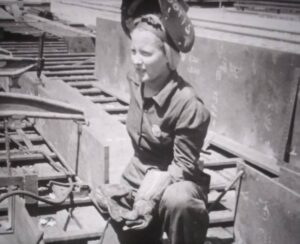
WHEN WORK IS DONE
US Government, Office of War Information, Beureau of Motion Pictures in cooperation with the Division of Recreation, Office of Community War Services, Federal Security Agency. Released April 15, 1943.
Documentary urging Americans to accept war workers into their homes and to plan social activities in their communities to include these war workers.
(1943 Kodak film stock, variable area sound track)
_______________________________________________
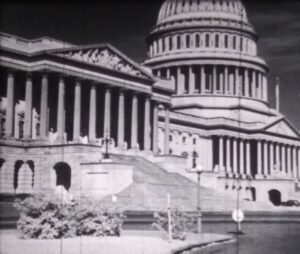
WASHINGTON
Castle Films, 1939.
Beautiful tour of Washington D.C. on the eve of war. Lots of shots above the buildings and monuments taken from a blimp that can sometimes be seen in the sky and other times as a shadow on the ground. The narrator refers to the Supreme Court building and the West Wing of the White House as being new.
(1940 Kodak film stock, density sound track)
_____________________________________
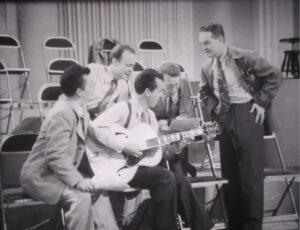
HIT KIT
Army-Navy Screen Magazine. Produced by Army Pictorial Service in cooperation with the Music Section, Special Services Division, c. 1943
Fred Warring and his Pennsylvanians explain how they select songs they think will become hits with the GIs, then they perform “In My Arms” by Frank Loesser and Ted Grouya. As performed here this catchy tune will get stuck in your head.
NOTE: Shown only in military theaters, this film includes some racially insensitive cartoon images and cartoon drawings of bare-breasted women. (1969 Eastman dupe, density track)
________________________________________________
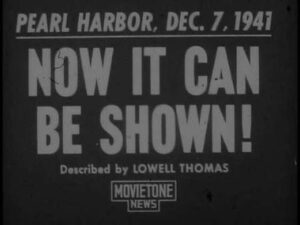
FOX MOVIETONE NEWSREEL
OF PEARL HARBOR
(Fox Movietone, 1942)
This historic newsreel shows film of the attack on Pearl Harbor that was embargoed by the government for security reasons until a year after the attack. This was the first motion picture footage showing Americans just how extensive was the damage at Pearl Harbor. We even see footage of the USS Arizona exploding.
Then we are shown footage of the resurrection of some of the sunken ships and the rebuilding of the Navy.
Narrated by Lowell Thomas. (1974 Eastman film stock, variable area sound track)
______________________________________________
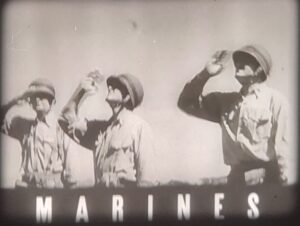
MARINE’S HYMN
Produced by Office of War Information Bureau of Motion Pictures.
There is no definitive version of the origins of The Marine’s Hymn. But it is generally assumed that the tune was adapted from a melody in “Genevieve de Brabant,” an 1859 comic opera by Jacques Offenbach. Tradition says that the words to the first verse were written by an anonymous Marine on duty following the Mexican War in 1848. It was not until 1929 that the words to three verses were officially recognized. These words were amended slightly in 1942 to say “In air, on land and sea” to reflect the addition of air power to the Marine’s arsenal. This film uses the 1929 “On the land and on the sea” version. (1952 Kodak film stock, variable area sound track)
____________________________________________
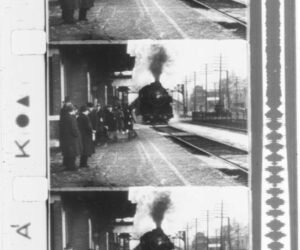
RIGHT OF WAY
(Produced by the Office of War Information Bureau of Motion Pictures, c. 1943)
Government newsreel explaining to civilians why they must be patient and accept that the needs of war must have precedence over their personal transportation needs. We see several excellent shots of trains and a quick peak inside the national center where train traffic was controlled.
Explaining everything is Joseph B. Eastman (1882-1944), Director of the Office of Defense Transportation. (1943 Kodak film stock, variable area sound track)
____________________________________________
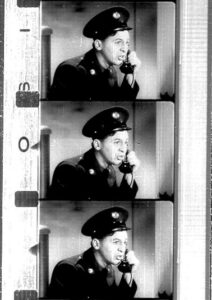
SAFEGUARDING MILITARY INFORMATION
Official War Film 11-324
(Produced by Signal Corps, 1941, Through the cooperation of Research Council, Academy of Motion Picture Arts and Sciences. Directed by Preston Sturges, uncredited.)
Spies are among us! “Every regulation safeguarding military information, unimportant though it may seem, is based on sound reason born of experience. A careless word, a seemingly harmless boast, may cost the lives of hundreds of your countrymen and jeopardize the security of your homeland.”
“Thoughtlessness Breeds Sabotage” is the cumbersome phrase promoted in this film. That was soon replaced by the more euphonious “Loose lips sink ships.”
Produced shortly before Pearl Harbor but released shortly after, this fascinating film is also a fun test of your movie knowledge – look for some uncredited but famous Hollywood faces including Eddie Bracken (seen in photo above), Ginger Rogers, Ian Hunter and Walter Huston. (1942 Kodak stock, density sound track)
_______________________________________
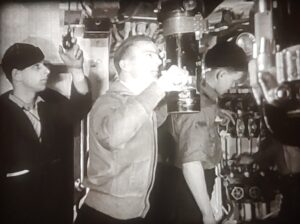
SALUTE TO THE NAVY
(Castle Film #148, offered in the catalogue for only two years: 1944-1946, “Your commentator is Ray Henley.”)
Castle Films was founded by Eugene Castle, a former newsreel cameraman, to produce films for the home market. Some of Castle’s newsreels are as slick as anything produced for theatrical distribution by Fox Movietone or Pathé.
This rousing salute to the US Navy is an excellent example of the quality of movies that Castle made for showing in your own home. As most homeowners did not own projectors with sound capabilities Castle offered both sound and silent versions of his films. This is a rare sound print of this vintage Castle production. (1943 Kodak film stock, variable area sound track)
____________________________________
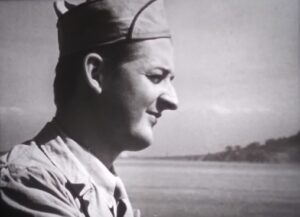
ARMY-NAVY SCREEN MAGAZINE #46
THE STORY OF CPL. JOLLEY
A pictorial report from all fronts for the armed forces only. Produced by Army Information Branch, Army Pictorial Service, Air Forces, Navy Department, in cooperation with all united nations. Released July, 1945.
Shown only to members of the armed forces, this film is a first person account from Cpl. Alfred Jolly, (July 20, 1923-September 23, 1966). Cpl Jolley (seen in photo above) tells us about the Bataan Death March, his three and a half years as a Japanese slave/prisoner of war, of his liberation on January 30, 1945 and his homecoming to San Francisco.
Jolley lost his left arm in the attack on Corrigedor and managed to survive captivity as a disabled slave/POW. (1945 Kodak film stock, variable area sound track)
_____________________________________________
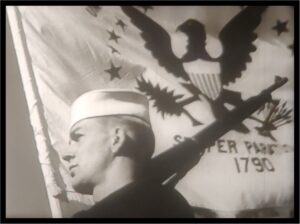
SEMPER PERATUS – UNITED STATES COAST GUARD
Produced by the Office of War Information Bureau of Motion Pictures, Photographed by the United States Coast Guard. (1943)
Inspiring images of the U.S. Coast Guard in training and in action accompanied by the official march of the Coast Guard, “Semper Peratus,” (Latin for “Always Ready”), composed in 1927 by Coast Guard Captain Francis Saltus Van Boskerck. A new first verse was written in 1943 by Homer Smith and Lieutenant Walton Butterfield. This film uses that new verse and the original third verse, eliminating the second verse.
In this film the first two lines of the chorus were changed slightly from “This is the Coast Guard’s marching song. We sing on land and sea,” to “All hail the Coast Guard’s marching song. We sing on land or sea.” In 1969 the opening lines of the chorus were officially changed to “We’re always ready for the call. We place our trust in Thee.” (1943 Kodak film stock, variable area sound track)
|
ARMY-NAVY SCREEN MAGAZINE #41
Released to military theaters in November, 1944. “A pictorial report from all fronts for the armed forces only, produced by Army Information Branch, Army Pictorial Service, Air Forces, Navy Department, in cooperation with all united nations.
Shown only to members of the armed forces, this film begins with a newsreel showing some American fliers whom the Russians had liberated from a Nazi POW camp in Romania. There is some very historic footage here, including excerpts from the welcome home address given by the commanding officers when the former POWs arrived in Italy.
The rest of the film presents “an Army-Navy Screen Magazine Special: Christmas 1944.” Featured is Leopold Stokowski who addresses the military audience through the camera lens and then conducts the Westminster College Choir (from Princeton, New Jersey) in some Christmas Carols, inviting us to sing along with them to the words on the bottom of the screen.
Then “Stokie” introduces “my good friend, Miss Marian Anderson,” the legendary American contralto who also speaks to us through the camera and then sings Schubert’s “Ave Maria.” The film ends with Stokie inviting us to sing along to more carols. (Composite print on 1944 and 1947 Kodak film stocks, variable area sound track)
(Photo above of Anderson and Stokowski courtesy of Westminster College)
Silver Showcase is proud to have provided footage from this very rare print to be used in the recent documentary “Once in a Hundred Years-the Life and Legacy of Marian Anderson,” (2019) which aired on PBS.
“The Army-Navy Screen Magazine” was a bi-weekly series produced from June of 1943 until early 1946 by the Army Signal Corps under the supervision of Frank Capra. It was said to have reached over 4 million military men and women every week.
NOTE: some incidental nudity is seen briefly in the early part of the film when the liberated Americans are shown walking into the showers. As this was a military film and never shown in civilian theaters nudity was not prohibited.
_____________________________________________
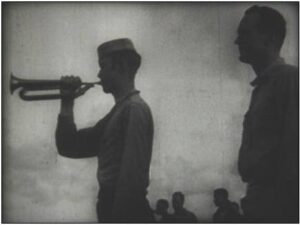
ARMY-NAVY SCREEN MAGAZINE #46
Released to military theatres late in 1944. “A pictorial report from all fronts for the armed forces only, produced by Army Information Branch, Army Pictorial Service, Air Forces, Navy Department, in cooperation with all united nations.”
This edition of the Army-Navy Screen Magazine is exclusively about the 2nd Battle of the Philippines which is now considered the beginning of the end of the war for Japan.
We get to see some amazing Signal Corps footage, gun camera footage, and some captured Japanese footage. Explained is the strategy we used for this battle.
The film closes with the memorial service for a pilot who died in his cockpit when his plane crash landed on the deck of the carrier. He is buried at sea in his plane. (1944 Kodak film stock, variable area sound track)
___________________________________________
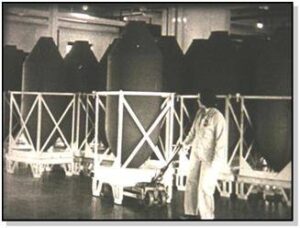
SPECIAL DELIVERY – JAPAN
Released to US war workers in 1945. Official U.S. War Film #56 produced by the Army Signal Corps for the War Department, “with the cooperation of the combat film units from Signal Corps, Army Air Forces, Navy and Marines.” “Exclusive for the men and women of American industry.”
Aimed at American defense workers in munitions plants this film explains that the lives of our fighting men and the very future of the nation depend on their working hard to produce as much ammunition as possible.
The various kinds of big guns, what they sounded like and their ranges, are demonstrated. This film also explains how much ammunition is used in battle each day and how difficult it is to get that ammunition to the South Pacific. (1945 Kodak film stock, variable area sound track)
____________________________________________
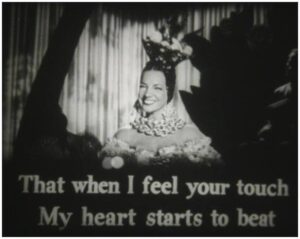
SING WITH THE STARS
featuring CARMEN MIRANDA
G.I. Weekly. Produced by Army Pictorial Service in cooperation with the Music Section, Special Services Division, c. 1944
Carmen Miranda, with her wonderful fruit filled hats, addresses the G.I. audience, engages in a gibberish routine with Richard Lane and leads the audience in an exuberant bouncing ball sing-along of Miranda favorites.
As usual this pint sized lady with the atomic personality makes fun of everything, the bouncing ball, American slang and even herself in a great performance she filmed exclusively for the military audience.
This very rare film is missing from most of Miranda’s filmographies and has been mostly unseen since it was shown exclusively to our fighting forces in 1944. (Undated and unidentified film stock, variable area sound track.)
______________________________________________
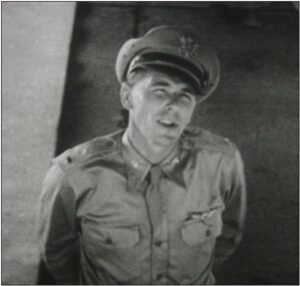
REAR GUNNER
Warner Bros. April 10, 1943
A rousing recruitment film for the Army Air Corps starring Burgess Meredith as Pvt. Peewee Williams who goes to rear gunner school and is ultimately decorated for bravery.
Along the way we get to see the kind of training it took to become a rear gunner.
This film is a great example of how Hollywood was supportive of the war effort. It is a recruiting film that is also very entertaining. This film makes the job of rear gunner seem to be the best job on the plane, but in reality, it was the most dangerous job on the plane.
Also seen are Ronald Reagan, Tom Neal and Dane Clark. Knox Manning narrates. (Unidentified and undated film stock, variable area sound track)
__________________________________________________
ALL STAR BOND RALLY
20th Century Fox for the US Treasury’s 7th and final war bond drive, released May 10, 1945.
Radio’s beloved couple Fibber McGee and Molly attend a war bond rally at their local theatre.
Among the many stars on stage are Betty Grable dancing and showing off her famous legs, Frank Sinatra crooning with Harry James and his Orchestra, Harpo Marx chasing a blonde and playing his harp, and Bing Crosby singing and trading barbs with Master of Ceremonies Bob Hope.
Written by long time writer for Fibber and Molly, Don Quin, it’s all done in the spirit of supporting our fighting forces, a big war-time era theme of Quin’s, and buying war bonds. At the end of the show Fibber and Molly are going to ask you to buy a bond! (See photo above.) (1976 Eastman film stock, variable area sound track)
______________________________________________
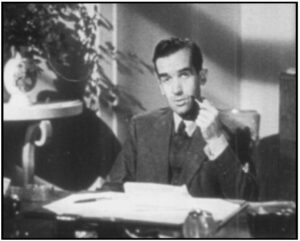
DOVER – Britain’s Front Line Revisited by Edward Murrow
United States Government/British Ministry of War Information. Released in the US by the Officer of War Information, November 26, 1942.
Legendary broadcast journalism pioneer Edward R. Murrow reports on the activities, determination and high spirits of the British people following the Blitz. (Kodak 1943 film stock, variable area sound track)
______________________________________________
THE CHANNEL ISLANDS – 1940-1945
Crown Film Unit, 1945.
In the summer of 1940 the Germans occupied the Channel Islands, a small archipelago in the English Channel, the only part of the British Isles to be occupied by the Nazis during WWII.
In this fascinating film the Channel Islanders themselves show us what it was like to live under Hitler’s thumb, how their horses and cows were confiscated as well as their radios, how they resorted to traveling around the islands in carts pulled by malnourished horses or riding their bikes on the rims because the Germans confiscated their tires, and how various residents secretly built crystal radios to be able to listen to the BBC and keep up on the news of the war.
New clothes were simply not available. “It was a case of mending your mending” the narrator explains as we watch an Islander try to mend clothes riddled with holes. Many residents, including children, ended up wearing out their shoes completely and going barefoot.
The Germans also held slaves on the islands who came from Russia and other countries. Many of those slaves died during the war and were buried on the Islands.
Food was rationed and as the war was coming to an end what little food they had was often stolen by Nazi soldiers who were also hungry. When the war ended and real food began to arrive from England and the Red Cross, it was a revelation to the children, many of whom did not even know what an orange looked like.
Largely unseen by the public since 1945, this film allows the Channel Islanders themselves to tell us about the occupation in their own words. (1945 British Kodak film stock, density sound track)
__________________________________________________
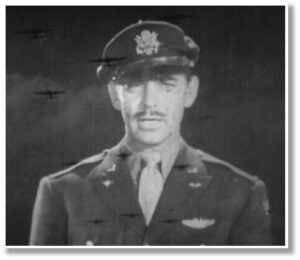
WINGS UP
First Motion Picture Unit, United States Army Air Forces, US Office of War Information, distributed by MGM, Office of War Information Division of Motion Pictures, War Activities Committee of the Motion Picture Industry. Narrated by Captain Clark Gable. Released to civilian theaters on May 27, 1943.
After his wife, Carole Lombard, died in a plane crash early in 1942, the grieving Clark Gable (1901-1960, see photo above) set his Hollywood career aside and joined the Army Air Forces.
Offered a commission, Gable turned it down saying he wanted to earn it, and he did. He graduated from the Officers Candidate School in Florida, was trained as a gunner, appointed head of a motion picture unit and assigned to film aerial gunners in combat.
Gable flew five combat missions over Germany, officially. His fellow crew members said he flew many more than that. On one mission shrapnel passed through his boot and another crew member was killed. The damaged plane made it back to England and crash landed in a swamp.
Gable was sent back to the states to make this movie which was filmed on location at the Officer’s Candidate School in Florida. This school was not for slackers! By the end of the film we have a healthy respect for what it took to become a WWII officer in the United States military.
Look quickly for actors Gilbert Roland and future Music Man Robert Preston as well as Green Bay Packers defensive back Hal van Every.
(Buy Savings Bond slug at beginning is on 1946 Kodak film stock with a dead sound track. The body of the film is on 1943 Kodak film stock with a density sound track.)
___________________________________________
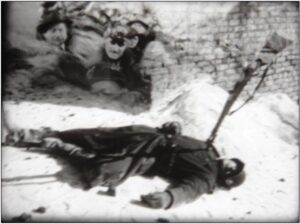
THE MOON IS DOWN (trailer)
20th Century Fox, 1943.
This is the theatrical trailer for the feature film version of John Steinbeck’s “The Moon is Down.” The narration is pure WWII propaganda: “Listen, Nazis, this is the end of your sorry road to glory.”
The complete feature starring Cedric Hardwicke, Henry Travers, Lee J. Cobb, Dorris Bowden and Margaret Wycherly is available for viewing from Silver Showcase. (1975 Eastman film stock, variable area sound track)
_____________________________________________
THE CALIFORNIA
JUNIOR SYMPHONY
Warner Bros., released April 18, 1942, re-released May 29, 1954.
Founded in 1936 by Russian immigrant Peter Meremblum (1890-1956), The California Junior Symphony is an outstanding youth orchestra of children aged six to eighteen years old who play better than most adult community orchestras. This film explains that some of the orchestra members are children from other lands who came here so they could play the kind of music they want to play, and then they play it exceptionally well.
This film seems to be the only motion picture record of founder Peter Meremblum (see photo above) conducting the orchestra that he founded. He does not appear in other films that feature his orchestra. (1959 Kodak film stock, density sound track)
_____________________________________
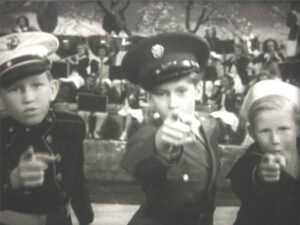
CHILDHOOD DAYS
Warner Bros., released June 5, 1943.
It’s hokey, it’s schmaltzy, it’s over-the-top patriotic propaganda, and it’s all done with children.
The California Junior Symphony is lead, in this film, by nine year old Diana Hale. The Alvarez Sisters sing “Tonight We Love” (the popular Freddie Martin version of Tchaikovski’s Piano Concerto), the orchestra plays “Perpetual Motion” by Johann Strauss, and everybody performs “The Good Old American Way” for the finale, which will never take the place of any George M. Cohan flag waver but the enthusiasm of the kids makes it fun. (Gevaert Belgium 1S film stock, density sound track)
Note: The California Junior Symphony is prominently seen in the feature length “They Shall Have Music” (Goldwyn, 1939) which stars legendary violinist Jascha Heifitz. This seldom seen film is available for screenings from Silver Showcase.
____________________________________________
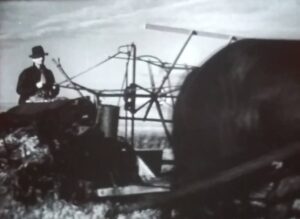
ACCORDING TO NEED
National Film Board of Canada, 1944.
The needs of individuals and the needs of war are shown when a farmer needs to replace a broken piece of farm equipment so that he can get the crop in by sundown.
It is seen that even the smallest issue for a farmer can affect the world situation in war time. We see government officials in Canada, the US and Australia discussing how to get either food or equipment to our Allies and liberated countries in Europe.
(1944 Kodak film stock, density sound track)
________________________________________________
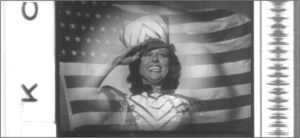
I AM AN AMERICAN
Soundie Corporation of America, 1941.
This 1940 song by Ira Schuster, Paul Cunningham and Leonard Whitcup was very popular during the war and was sung in school rooms across the country. It is performed here by Carolyn Marsh, (seen in photo above).
Soundies were a forerunner of music videos. They were produced on 16mm film loops, ran for three minutes and were played in Panorams, (movie “juke boxes”) in restaurants, bars, train and bus stations, and other public establishments.
(1946 Kodak film stock, variable area sound track)
________________________________________
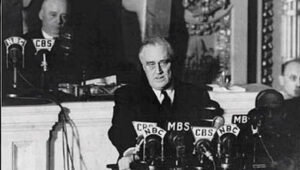
FDR DECLARATION
OF WAR SPEECH
(Blackhawk Films reconstruction of FDR’s speech.)
Listening to this speech is one thing. Watching Roosevelt deliver it is another!
Although clips from this iconic speech had been seen in newsreels, a filmed record of the complete speech was never issued. Blackhawk films rectified that situation in the late 20th century by piecing together footage from various newsreels. They did edit out some of the applause, but the entire speech can now be watched thanks to this film. (2007 Kod.ak film stock, variable area sound track)
___________________________________________
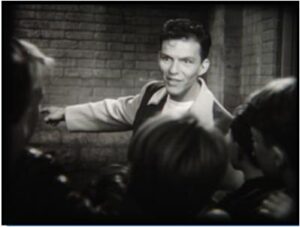
THE HOUSE I LIVE IN
(RKO, November 9, 1945)
Frank Sinatra (1915-1998) lectures some street kids about tolerance and sings “The House I Live In,” (words by Lewis Allen, music by Earl Robinson) a song about the different religions and ethnic groups that make up America.
This legendary film won an honorary Academy Award “for promoting tolerance,” and a Golden Globe as “Best film for promoting international understanding.” Sinatra also sings “If You Are But a Dream,” (written by Moe Jaffe, Jack Fulton and Nat Bonx). Added to the National Film Registry in 2007 for it’s “historical, cultural and aesthetic contributions” to America.
There is more to the background of this film than the public or even the filmmakers knew at the time. We’ll talk about that when you screen this film. (1946 Kodak film stock, variable area sound track)
_____________________________________________
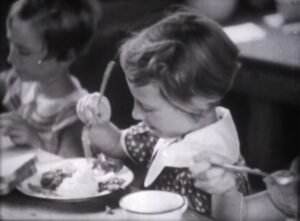
OUR CHILDREN
(The US Navy, US Marine Corps and the US Coast Guard, c. 1945)
Post-war plea to buy Victory Bonds because we need to help the children of the world today so they don’t grow up bitter and start another war. Narrated by Gene Kelly, (uncredited). (1945 Kodak film stock, variable area sound track)
________________________________________________
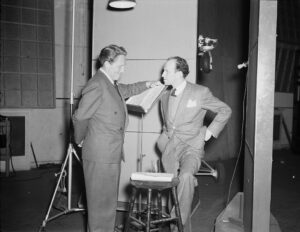
RING OF STEEL
(Warner Bros/Office of Emergency Management, April 2, 1942)
This stirring tribute to the American soldier is narrated by Spencer Tracy (1900-1967, a veteran of WWI), written by Wallace Russell and with music by Morton Gould. It was directed by Garson Kanin and produced by Philip Martin Jr. (Photo above shows Tracy and Kanin recording the narration in the Signal Corps studio.)
Using stock footage from the Warner Bros. library, this film tells the story of America’s military history from the perspective of the American Soldier beginning with Lexington and Concord and ending with the First World War. The film ends urging young Americans to enlist to defend freedom. (Composite print on Kodak 1941 and 1942 film stocks, density sound track)
____________________________________________
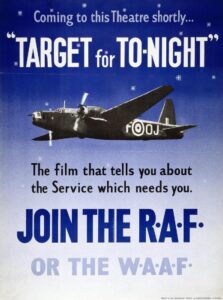
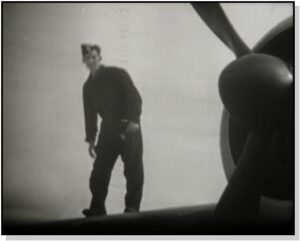
TARGET FOR TONIGHT
(Crown Film Unit, Ministry of Information, Released in the US on October 17, 1941)
The first Allied wartime documentary to take an offensive rather than a defensive war attitude was director Harry Watt’s “Target for Tonight.” It recreates the planning and execution of a Royal Air Force bombing run over Germany. Featuring mostly genuine RAF personnel, it tells the story of the crew of F for Freddie, a Wellington bomber.
Psychologically it was well timed, appearing in the UK in the latter half of 1941 after the blitz, at a time when the war was in a weary stage for Britain. It was shown as a first feature in cinemas not only in Britain but in 12,000 cinemas in the Americas. It’s propaganda effect was incalculable, not only for morale-boosting in the UK, but for showing the world that there was no question of Britain being finished. It was seen by 50 million in the U.S. and is credited with helping to turn American’s attitude toward siding with England in the war.
It was filmed the last two weeks of March and 1st two weeks of April in 1941 at RAF Mildenhall, (for security purposes identified in the film as Millerton Aerodrome), and RAF Bomber Command headquarters in High Wycombe.
The names of the personnel were changed so that, in the event that they were captured by the Germans, their participation in this film would not be used against them. Squadron Leader Dickson who skippers “F for Freddie,” was played by Percy Charles Pickard. Pickard later lost his life in a raid to rescue prisoners. After the war director Harry Watt noted that most of the officers and flight crew who appeared in the film did not survive the war.
“Target for Tonight” earned an honorary Academy Award (1942) for “its vivid and dramatic presentation of the heroism of the RAF in the documentary film.” It won Best Documentary in 1941 from the National Board of Review.
This vintage war-time-era print is missing the opening title credit, but everything else is there and in excellent condition. (1942 Kodak film stock, variable area sound track)
|
